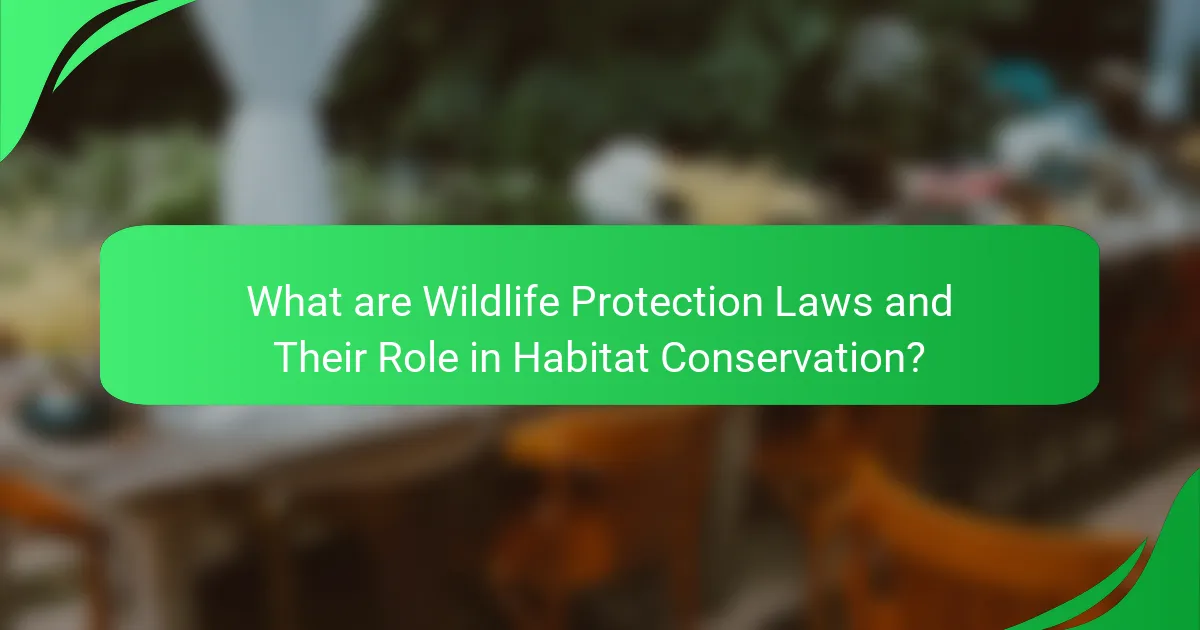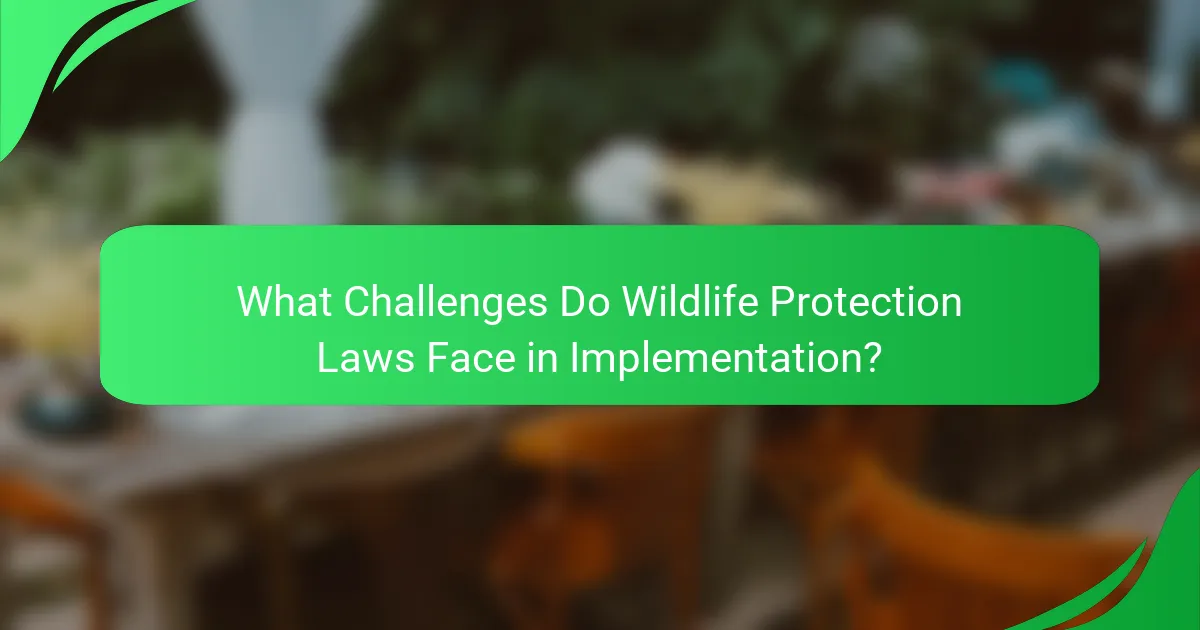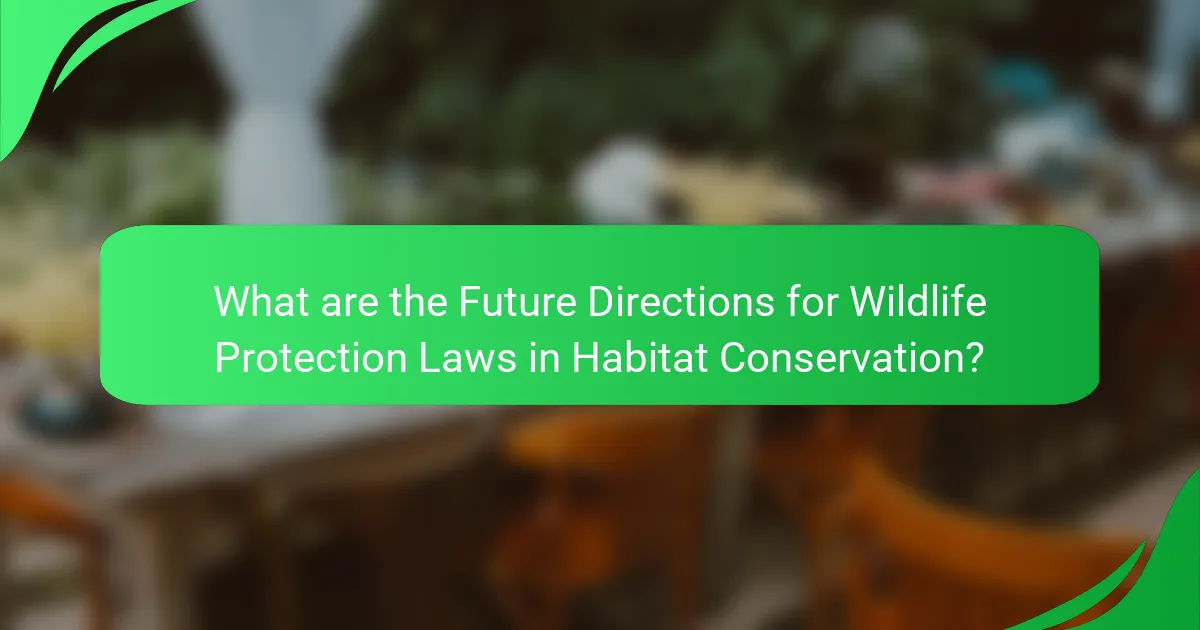Wildlife protection laws are legal regulations aimed at safeguarding animal species and their habitats from threats such as poaching, illegal trade, and habitat destruction. These laws establish protected areas like national parks and wildlife reserves, crucial for the survival of endangered species. Despite their importance, the implementation of these laws faces challenges, including inadequate funding, corruption, and local opposition. Future directions for enhancing wildlife protection include stronger legal frameworks, improved enforcement mechanisms, and increased collaboration among stakeholders. This comprehensive overview highlights the significance of wildlife protection laws in habitat conservation and their role in maintaining ecological balance.

What are Wildlife Protection Laws and Their Role in Habitat Conservation?
Wildlife protection laws are legal regulations designed to safeguard animal species and their habitats. These laws aim to prevent poaching, illegal trade, and habitat destruction. They establish protected areas, such as national parks and wildlife reserves. Such areas provide safe environments for endangered species. For example, the Endangered Species Act in the United States protects species at risk of extinction. This act also supports habitat conservation efforts by prohibiting actions that harm these species or their ecosystems. Effective enforcement of these laws is crucial for their success. Studies show that areas with stringent wildlife protection laws experience better biodiversity outcomes. Therefore, wildlife protection laws play a vital role in habitat conservation by ensuring the survival of species and maintaining ecological balance.
How do Wildlife Protection Laws contribute to ecosystem preservation?
Wildlife Protection Laws contribute to ecosystem preservation by safeguarding biodiversity and habitats. These laws regulate hunting, poaching, and trade of endangered species. By protecting wildlife, these laws help maintain ecological balance. Healthy populations of species are essential for pollination, seed dispersal, and nutrient cycling. For example, the Endangered Species Act in the U.S. has led to the recovery of species like the American bald eagle. This recovery has positive ripple effects on their habitats and other species. Furthermore, protected areas under these laws prevent habitat destruction from development and pollution. Overall, Wildlife Protection Laws are crucial for sustaining ecosystems and the services they provide.
What specific protections do these laws provide for endangered species?
Wildlife protection laws provide specific protections for endangered species by prohibiting their hunting, capturing, or killing. These laws establish critical habitats to ensure the survival of these species. They also regulate trade and commerce of endangered species and their products. Additionally, these laws promote recovery plans aimed at increasing population numbers. The Endangered Species Act, for example, has successfully led to the recovery of several species, demonstrating its effectiveness. According to the U.S. Fish and Wildlife Service, species listed under this act have a higher chance of survival than those not listed.
How do these laws impact biodiversity within habitats?
Wildlife protection laws positively impact biodiversity within habitats. These laws regulate activities that threaten species and ecosystems. They establish protected areas, which serve as safe havens for diverse species. Research shows that protected areas can increase species richness by up to 30%. These laws also promote sustainable practices, reducing habitat destruction. By mitigating pollution and illegal hunting, biodiversity is preserved. Studies indicate that effective enforcement of these laws leads to healthier ecosystems. Overall, wildlife protection laws are crucial for maintaining and enhancing biodiversity in various habitats.
Why are Wildlife Protection Laws significant for sustainable development?
Wildlife protection laws are significant for sustainable development because they ensure the conservation of biodiversity. Biodiversity is essential for ecosystem stability and resilience. Healthy ecosystems provide vital services, such as clean air, water, and food security. These laws help prevent habitat destruction and overexploitation of species. For example, the Endangered Species Act in the U.S. has contributed to the recovery of various species. Studies show that protecting wildlife habitats can enhance carbon sequestration, combating climate change. Furthermore, sustainable tourism can thrive in areas with strong wildlife protections, boosting local economies. Overall, these laws play a crucial role in balancing environmental health and human development.
How do these laws balance human activity and wildlife conservation?
Wildlife protection laws balance human activity and wildlife conservation by regulating land use and resource extraction. These laws establish protected areas where human activities are limited. They also set guidelines for sustainable practices in agriculture, forestry, and fishing. By doing so, they minimize habitat destruction and promote biodiversity. For example, the Endangered Species Act in the U.S. protects species at risk and their habitats. This law requires federal agencies to ensure that their actions do not jeopardize these species. Additionally, conservation easements allow landowners to retain property rights while restricting development. Such measures create harmony between human needs and ecological preservation.
What economic benefits arise from enforcing Wildlife Protection Laws?
Enforcing Wildlife Protection Laws generates significant economic benefits. These laws help preserve biodiversity, which is crucial for ecosystem services. Healthy ecosystems provide resources like clean water and pollination, boosting agriculture and fisheries. The tourism industry thrives on wildlife, contributing billions to local economies. For instance, ecotourism in countries like Costa Rica generates over $3 billion annually. Protecting wildlife also encourages sustainable practices, leading to long-term economic stability. Additionally, it reduces costs associated with habitat degradation and species extinction. Overall, enforcing these laws fosters a balance between economic growth and environmental conservation.

What Challenges Do Wildlife Protection Laws Face in Implementation?
Wildlife protection laws face significant challenges in implementation. Enforcement often suffers from insufficient funding and resources. Many regions lack adequate personnel to monitor compliance effectively. Corruption can undermine efforts to uphold these laws. Local communities may oppose regulations due to economic pressures. Conflicts arise between conservation goals and development projects. Additionally, legal loopholes can hinder the prosecution of violators. Education and awareness about wildlife protection are often lacking in affected areas. These factors collectively impede the successful implementation of wildlife protection laws.
How do enforcement issues affect the effectiveness of these laws?
Enforcement issues significantly reduce the effectiveness of wildlife protection laws. When laws are not properly enforced, illegal activities such as poaching and habitat destruction increase. A lack of resources, training, and personnel hampers law enforcement agencies. For example, in regions with high rates of wildlife crime, enforcement agencies often lack funding for patrols and monitoring. Additionally, corruption within enforcement bodies can lead to ineffective law implementation. Studies show that areas with strong enforcement see a marked decrease in illegal wildlife trade. Conversely, regions with weak enforcement experience ongoing violations. Therefore, effective enforcement is crucial for the success of wildlife protection laws.
What role do local communities play in the enforcement of Wildlife Protection Laws?
Local communities play a crucial role in the enforcement of Wildlife Protection Laws. They often serve as the first line of defense against poaching and illegal wildlife trade. Community members are more likely to report violations due to their close connection with the environment. Their involvement fosters a sense of stewardship over local wildlife and habitats.
Additionally, local communities can participate in monitoring and patrolling efforts. Collaborative programs between communities and government agencies enhance law enforcement effectiveness. Studies show that areas with community involvement see a significant decrease in wildlife crime. For example, community-based conservation initiatives in Africa have led to a 50% reduction in poaching rates.
Overall, local communities are essential allies in the enforcement of Wildlife Protection Laws, contributing to sustainable habitat conservation.
How can corruption undermine wildlife protection efforts?
Corruption can severely undermine wildlife protection efforts by facilitating illegal activities such as poaching and habitat destruction. Corrupt officials may accept bribes to overlook violations of wildlife laws. This creates an environment where illegal hunting and trafficking can thrive without consequences. A report by the United Nations Office on Drugs and Crime states that wildlife crime generates billions in illicit profits annually. Corruption also diverts funds meant for conservation to personal gain, weakening enforcement capabilities. Consequently, protected areas may lack necessary resources for monitoring and protection. The absence of accountability fosters a culture of impunity among offenders. Ultimately, corruption erodes trust in institutions responsible for wildlife conservation.
Why is public awareness crucial for the success of Wildlife Protection Laws?
Public awareness is crucial for the success of Wildlife Protection Laws because it fosters community engagement and compliance. When people understand the importance of wildlife conservation, they are more likely to support and adhere to these laws. Increased awareness can lead to greater public participation in conservation efforts. For instance, studies show that communities involved in wildlife protection initiatives report higher levels of compliance with regulations. Additionally, informed citizens can advocate for stronger protections and policies, influencing lawmakers. Public awareness campaigns can educate individuals about endangered species and the ecological impacts of biodiversity loss. Effective communication strategies can mobilize community action, leading to successful wildlife conservation outcomes.
What strategies can be used to educate the public about wildlife conservation?
Effective strategies to educate the public about wildlife conservation include community engagement, educational programs, and media outreach. Community engagement fosters local involvement in conservation efforts. This can be achieved through workshops, volunteer programs, and citizen science initiatives. Educational programs in schools raise awareness from a young age. These programs often include field trips to natural reserves and interactive lessons.
Media outreach utilizes social media, documentaries, and public service announcements. These platforms can reach a broad audience quickly. According to a study by the World Wildlife Fund, social media campaigns can increase public interest in conservation by over 30%. Collaborations with influencers can further amplify these messages.
Lastly, partnerships with local organizations enhance the effectiveness of conservation education. These collaborations can provide resources and expertise. Together, these strategies create a comprehensive approach to raising awareness about wildlife conservation.
How does community involvement enhance the effectiveness of these laws?
Community involvement enhances the effectiveness of wildlife protection laws by fostering local stewardship. When communities actively participate, they develop a sense of ownership over local habitats. This engagement leads to increased vigilance against illegal activities, such as poaching and habitat destruction. Studies show that areas with strong community involvement see improved compliance with conservation laws. For example, the World Wildlife Fund reported that community-led initiatives in Kenya reduced poaching by 50%. Additionally, local knowledge contributes to better decision-making in conservation strategies. Engaged communities can also advocate for policies that reflect their needs and values. This collaboration between authorities and residents creates a more robust framework for enforcing wildlife protection laws.

What are the Future Directions for Wildlife Protection Laws in Habitat Conservation?
Future directions for wildlife protection laws in habitat conservation include stronger legal frameworks and enhanced enforcement mechanisms. These laws aim to address the challenges posed by habitat loss and climate change. Increased collaboration among governments, NGOs, and local communities is essential for effective implementation. Integrating scientific research into policy-making can improve conservation outcomes. Monitoring and evaluation systems will be critical to assess the effectiveness of these laws. Public awareness campaigns can foster community involvement in conservation efforts. Additionally, adapting laws to include emerging threats, such as invasive species, is necessary for comprehensive protection. These directions reflect a proactive approach to safeguarding biodiversity and ecosystems.
How can technology improve the enforcement of Wildlife Protection Laws?
Technology can significantly enhance the enforcement of Wildlife Protection Laws through various innovative methods. Drones can monitor wildlife habitats and detect illegal activities in real-time. GPS tracking devices can be used to monitor endangered species and ensure their safety. Mobile applications allow for the reporting of poaching incidents by citizens. Automated camera traps can capture images of poachers, providing evidence for legal action. Data analytics can identify patterns in wildlife crime, aiding law enforcement in resource allocation. The integration of blockchain can ensure transparency in wildlife trade and prevent illegal transactions. These technological advancements are supported by studies showing increased detection rates of wildlife crimes when technology is utilized.
What innovative practices are emerging in wildlife conservation efforts?
Innovative practices in wildlife conservation include the use of technology, community engagement, and habitat restoration. Drones are being deployed for monitoring wildlife and surveying habitats. This technology allows for real-time data collection and reduces human disturbance. Additionally, citizen science initiatives involve local communities in conservation efforts. These programs empower individuals to contribute data and observe wildlife, fostering a sense of stewardship. Habitat restoration projects are also gaining traction. They focus on rehabilitating degraded ecosystems to support biodiversity. These practices are informed by research showing that restored habitats can significantly enhance wildlife populations. Overall, these innovations are reshaping conservation strategies to be more effective and inclusive.
How can international cooperation enhance the effectiveness of these laws?
International cooperation can enhance the effectiveness of wildlife protection laws by fostering collaboration among nations. This collaboration allows for the sharing of resources, expertise, and best practices in conservation efforts. For instance, countries can coordinate enforcement actions against poaching and illegal wildlife trade, which often crosses borders. Joint initiatives can lead to more comprehensive habitat protection strategies. Additionally, international treaties, such as the Convention on International Trade in Endangered Species (CITES), establish common standards for wildlife protection. These treaties facilitate information exchange and promote accountability among member states. Consequently, international cooperation strengthens the overall impact of wildlife protection laws, making conservation efforts more effective.
What best practices can be adopted for effective habitat conservation through Wildlife Protection Laws?
Effective habitat conservation through Wildlife Protection Laws can be achieved by implementing several best practices. First, establishing protected areas is crucial. These areas should encompass critical habitats and biodiversity hotspots. Second, engaging local communities in conservation efforts helps foster stewardship. Community involvement enhances compliance with protection laws. Third, enforcing regulations consistently is essential for maintaining habitat integrity. Strong enforcement deters illegal activities that threaten wildlife. Fourth, conducting regular assessments of habitats ensures adaptive management. Monitoring ecological health allows for timely interventions. Fifth, promoting sustainable land-use practices minimizes habitat degradation. Sustainable farming and forestry practices can coexist with wildlife conservation. Lastly, raising public awareness about the importance of wildlife conservation encourages broader support for protective measures. Education campaigns can drive community action and policy advocacy.
How can policymakers integrate scientific research into wildlife legislation?
Policymakers can integrate scientific research into wildlife legislation by utilizing evidence-based approaches. This involves collaborating with scientists to identify key issues affecting wildlife. Research findings can inform the development of regulations and conservation strategies. For example, studies on species population dynamics can guide protective measures. Additionally, policymakers can establish advisory committees that include researchers. These committees can review scientific data and recommend legislative changes. Regular assessments of wildlife health and habitat conditions can also be mandated. This ensures that laws remain relevant and effective over time. Engaging stakeholders, including conservationists and local communities, can further enhance the integration process.
What role do non-governmental organizations play in supporting wildlife protection efforts?
Non-governmental organizations (NGOs) play a critical role in supporting wildlife protection efforts. They engage in advocacy to influence policy changes that benefit wildlife conservation. NGOs often conduct research to gather data on endangered species and habitats. This research supports evidence-based decision-making for conservation strategies. Additionally, NGOs implement on-the-ground conservation projects that directly protect wildlife. They often collaborate with local communities to promote sustainable practices. Funding from NGOs helps finance conservation initiatives that governments may not prioritize. According to the World Wildlife Fund, NGOs are instrumental in raising public awareness about wildlife issues. Their efforts contribute significantly to global wildlife protection and habitat conservation.
Wildlife protection laws are legal frameworks established to safeguard animal species and their habitats, playing a crucial role in habitat conservation. These laws aim to prevent poaching, illegal trade, and habitat destruction while promoting biodiversity and ecosystem stability. Key aspects include the establishment of protected areas, specific protections for endangered species, and the economic benefits derived from enforcing these laws. Challenges such as enforcement issues and corruption hinder their effectiveness, while community involvement and public awareness are essential for successful implementation. Future directions focus on enhancing legal frameworks, integrating technology, and fostering international cooperation to improve conservation outcomes.